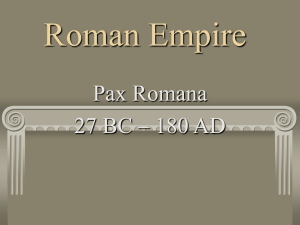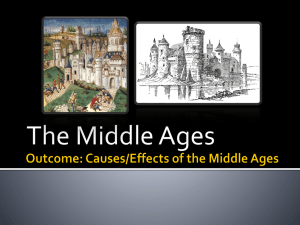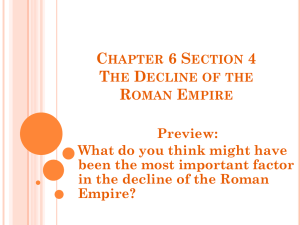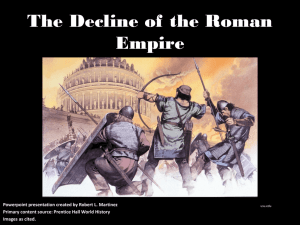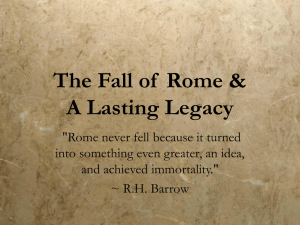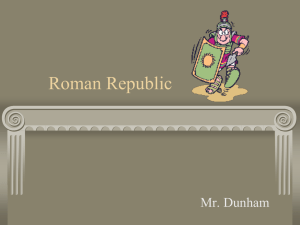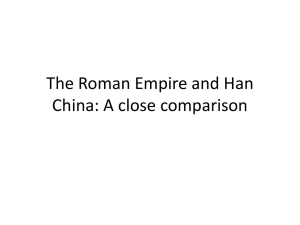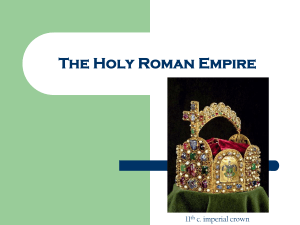Enclosing the West: The Early Roman Empire and Its
advertisement
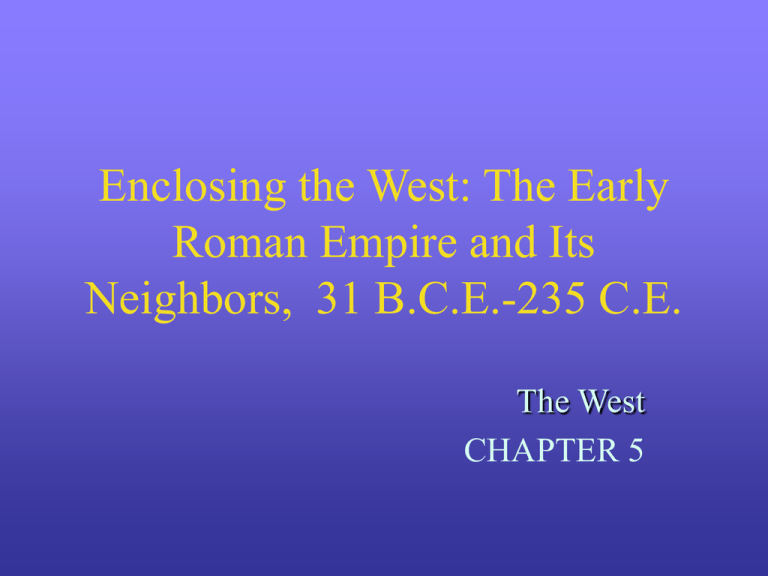
Enclosing the West: The Early Roman Empire and Its Neighbors, 31 B.C.E.-235 C.E. The West CHAPTER 5 Imperial Authority: Augustus and After • Behind the façade of a restored Republican tradition, Octavian (Augustus) created a Roman version of the Hellenic monarchy • Princeps (First Citizen) - all-powerful, but unobtrusive political position • Augustus’ heirs adopted the title Imperator, instead of Princeps • Principle of hereditary monarchy staved off political instability The Nature of Imperial Power • Defense and expansion of imperial territory • Administration of justice and provision of good government, through public infrastructure • Pontifex Maximus: supervision of religious worship • Symbol of unity and embodiment of the empire the cult of the emperor focused the allegiance of the empire’s diverse population The Agents of Control • The Senate - legislative arm of imperial rule • Public service and honor obtained via the Senate harnessed the Roman aristocracy and provincial élite to the imperial system • The Army - enforced peace, defended borders and conquered new lands • Military support was crucial to the emperor’s position and power The City of Rome • A monument to the authority of the emperor and to the power of the senatorial élite • The Forum was the physical, political and religious center of the city and the empire • Public works and buildings displayed imperial might • Majority of the city’s population lived in impoverished slums Conquest and Administration • Conquest fueled the Roman economy • Empire managed by a provincial system evolution of an administrative-military class • Imperial governors supervised the administration of the provinces by city councilors • Provincial government collected taxes, defended frontiers and administered justice The Provincial Cities • The civitas (city and surrounding land) was the basic unit of imperial government • Cities served as economic, legal and cultural centers • Each city modeled itself physically and politically on Rome • Each province had a unique legal and administrative system - the Law of the Province The Countryside • Land ownership in the countryside was the key to prosperity in the imperial system • Conditions for the peasantry varied across the empire • Legal system favored large, wealthy property owners over the rural poor • Agricultural productivity was very high Revolts Against Rome • Revolt of Arminius (9 C.E.): the only successful rebellion, led to the linguistic divide between Germanic and Romance languages in Europe • Enduring tribal allegiance fueled revolts in Britain and Gaul, but only for a few generations • Religious identity fueled revolts in Judea and allowed Jews to resist assimilation Forces of Romanization • Roman Army - bound together men from all provinces with a common culture, language and identity • Uniformity of Roman Law across provinces • 212 C.E. - the Antonine Decree granted citizenship to all free inhabitants of the empire, eliminating the distinction between conquerors and conquered Frontier Zones: Civilization and Barbarians • Physical and cultural demarcation along the empire’s frontiers • Heavily fortified borders represented limits of Roman authority and civilization • Romans defined their own identity, and justified their conquests, by viewing all who lived beyond the frontiers as barbarians Rome and the Parthian Empire • Parthian Empire, stretching from the Euphrates to the Indus, was the greatest rival to Rome • Majority of emperors favored diplomacy over conflict with Parthia • Commercial ties between Rome and Parthia favored an exchange of ideas and technologies between the two empires Roman Encounters with Germanic Peoples • The Germans posed the greatest threat to Rome • Never conquered or assimilated • Trade and cultural contacts spread Roman ideas and values into Germanic tribes • By the end of the second century C.E., Rome could no longer withstand the tide of Germanic invaders Roman Encounters with Asians and Africans • Rome had commercial, but not diplomatic, ties with imperial China • Demand for spices and other luxury items extended Roman trade networks as far east as Thailand and Java • Roman explorers ventured into sub-Saharan Africa, and commercial links may have existed between Rome and African peoples • Sub-Saharan Africa remained a place of myth and fantasy in Roman thought The Upper and Lower Classes • Social hierarchy of the Republic endured • Three aristocratic orders: senators, equestrians and city councilors • Plebeians - poor, but free, citizens • “Bread and circuses” - free grain and entertainment used to contain plebeian unrest Slaves and Freedmen • As much as 35 to 40 percent of the population of Italy were slaves ca. 30 B.C.E. • Ownership of slaves conveyed social status • Violence underpinned the institution of slavery • Freedmen (slaves who had obtained liberty) constituted an ambitious minority of the population • Economic importance of slavery declined in second century C.E. Women in the Roman Empire • Women of senatorial and equestrian rank possessed great freedom • The wives, mothers and other female relatives of the emperor could wield great, but unofficial, power • Female infanticide remained common Literature and the Empire • The new imperial system influenced literary styles • Virgil encapsulated the potential and the threat of imperial government in the Aeneid • Rhetoricians and historians analyzed imperial government • Advances in geography and astronomy, especially in the works of Claudius Ptolemy Religious Life • Roman religion was polytheistic and public • Syncretism spread a shared religious experience across the empire • After the destruction of the Second Temple, Rabbinic Judaism evolved • Rise of Christianity: appeal to marginalized groups, assimilation with classical philosophy, intolerance of other religions Rome Shapes the West • Boundaries of Roman Empire defined the geographical heart of the West • Rome transmitted Hellenistic and classical ideas into Europe • The cultural uniformity achieved within the Roman empire, between ca. 30 B.C.E. and 220 C.E., formed the foundation of Western civilization

